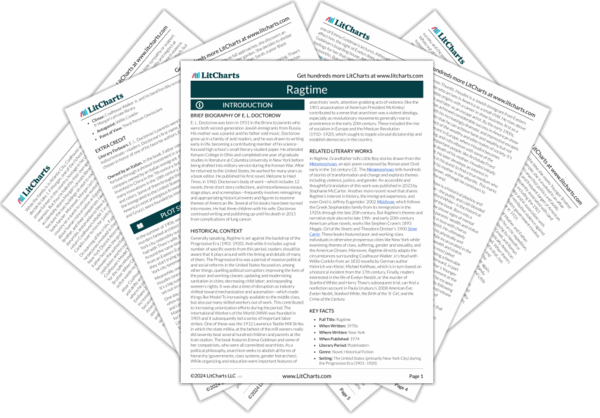Welcome to the LitCharts study guide on E. L. Doctorow's Ragtime. Created by the original team behind SparkNotes, LitCharts are the world's best literature guides.
Ragtime: Introduction
Ragtime: Plot Summary
Ragtime: Detailed Summary & Analysis
Ragtime: Themes
Ragtime: Quotes
Ragtime: Characters
Ragtime: Symbols
Ragtime: Theme Wheel
Brief Biography of E. L. Doctorow

Historical Context of Ragtime
Other Books Related to Ragtime
- Full Title: Ragtime
- When Written: 1970s
- Where Written: New York
- When Published: 1974
- Literary Period: Postmodern
- Genre: Novel, Historical Fiction
- Setting: The United States (primarily New York City) during the Progressive Era (1901–1920)
- Climax: Coalhouse Walker Jr. and his band forcibly occupy J. P. Morgan’s private library.
- Antagonist: Willie Conklin
- Point of View: Third-Person Omniscient
Extra Credit for Ragtime
Literary Forbears. E. L. Doctorow’s parents were both avid—if indiscriminate—readers. Doctorow’s first name, Edgar, was chosen in honor of one of his favorite authors, Edgar Allen Poe.
Owned by an Italian. In the book, Father rebuilds his family fortune through a shrewd investment in a small fireworks company owned by an Italian immigrant. Fireworks were invented in China in the 7th century, but Italians pioneered many innovations in the 18th century, including new shapes and colors. Some of them brought this expertise along when the immigrated to the United States. In fact, two of modern America’s most prestigious fireworks manufacturers, Zambelli and Grucci, were founded by immigrant families in the 1800s.







